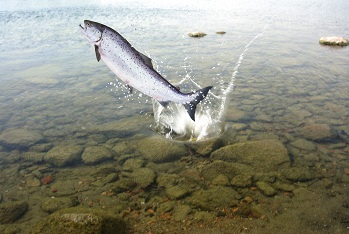Discovering why wild salmon is in decline

Related topics
Environment & climate action Aquatic Resources Innovation Marine and maritime and inland water research Denmark Finland France Ireland Spain United Kingdom Iceland Environment Food security, sustainable agriculture and forestry, maritime and martime inland water research and bio-economy Climate action, environment, resource efficiency and raw materials Norway Faroe Islandsdate: 24/03/2014
Project: Advancing understanding of Atlantic salm...
acronym: SALSEA-MERGE
See also: CORDIS
Contact: www.nasco.int/sas/salseamerge.htm
The SALSEA-MERGE team looked at the migration and distribution of fish at sea in relation to the river where they were born. By examining variations in their DNA and using the same technology used by detectives to solve crimes, scientists were able to identify individual groups of wild salmon.
“The research team found that a specific set of genes differed among fish from different regions and, for the very first time, it was possible to identify stock groups associated with different parts of Europe. By reading their DNA, scientists were able to tell which particular region an individual fish caught at sea came from,” explains Professor Ken Whelan, Research Director, Atlantic Salmon Trust, United Kingdom and SALSEA-MERGE project representative.
Highly accurate and cost-effective sensors (so-called electronic tags) built into the fish allowed scientists to trace both their horizontal and vertical movements in the ocean as well as their travel time. At the same time, the project team collected data on the environmental and oceano-graphic conditions which salmon faced. Novel high seas trawling technology (fishing nets towed behind the boats) was used to locate small and young salmon.
Although traditional tagging records existed, all the research work done previously had been with salmon returning from sea, with salmon in fresh water, or with juvenile salmon (smolts) going out to sea.
“This was the first time the salmon had been tracked on the high seas,” says Professor Whelan. Results from the marine surveys (years 2003 to 2010), which proved statistically significant, have revealed important differences in where salmon from different regions migrate. The SALSEA-MERGE team began to build up a picture of the various regional stocks of fish. It was exactly like putting together all the pieces of a jigsaw puzzle and a pattern began to emerge of differences in the use of the sea by different groups in good years when the fish survived really well (e.g. 2002) compared to the years when their survival rates at sea were very poor (e.g. 2008).
SALSEA-MERGE scientists looked at all the information they gathered in relation to the sea, not only the temperature, but also the speed of the currents and how the wind affected the surface currents of the ocean where the baby salmon would be located. The project team began to map out the ocean into sections so they could better understand the corridors and routes that the individual stocks of fish use at sea, where they go through and how they travel up and back down again.
“Global warming was the finding that went beyond what the scientists expected to discover. The likely effect of warmer seas and how this changes the type of organisms that live in the ocean meant that as seas are getting warmer the cold water plankton species on which the young salmon or post-smolts feed, have moved north with an estimated rate of 30km a year”, explains Professor Whelan.
In addition, as seas get warmer the relative abundance of plankton species changes and the species replacing the plankton suitable for the young salmon become more abundant and, in many areas, are quite different from the organisms the fish used to feed on.
According to Professor Whelan, salmon numbers may continue to decline in terms of overall survival as they may be adapting to these new conditions. The most important question at this stage is: will the salmon be able to adapt to these new conditions over time? This might require them to evolve new patterns of migration and behaviour, something that could take generations.
“Wild salmon has been around for 50 million years and my bet is they will be able to adapt, although it will take some time,” concludes Professor Whelan.
